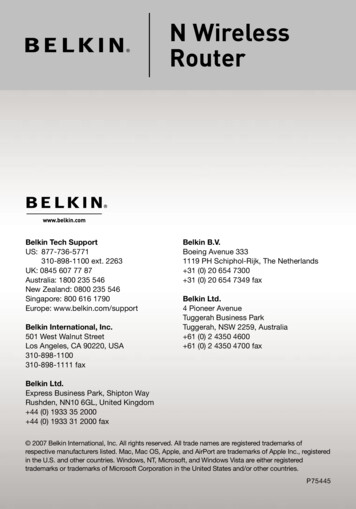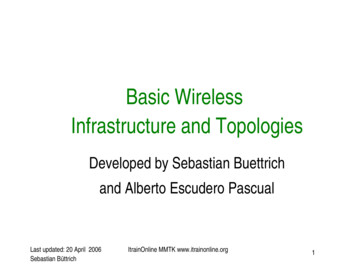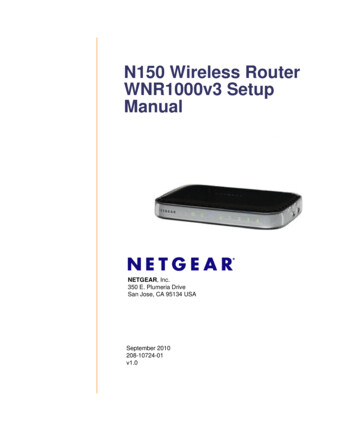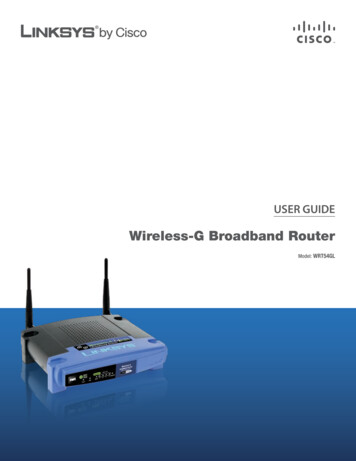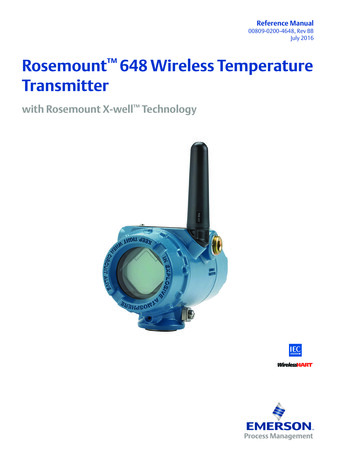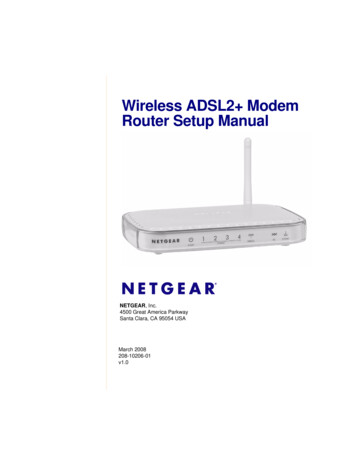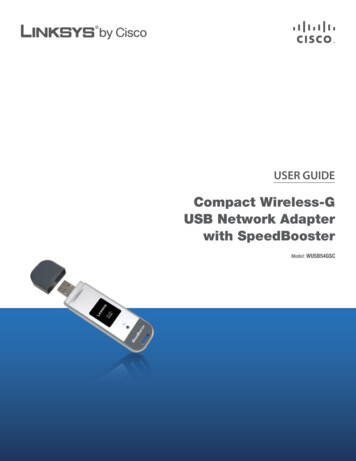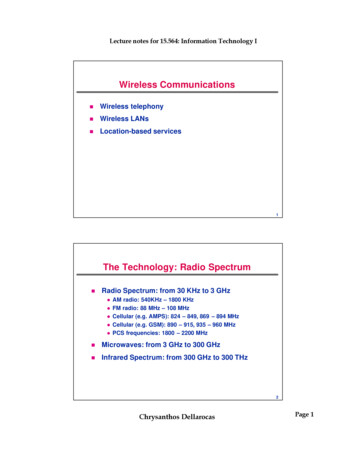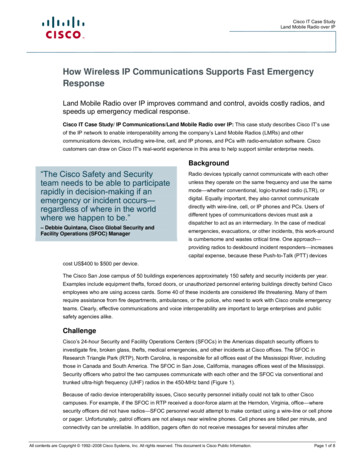
Transcription
Cisco IT Case StudyLand Mobile Radio over IPHow Wireless IP Communications Supports Fast EmergencyResponseLand Mobile Radio over IP improves command and control, avoids costly radios, andspeeds up emergency medical response.Cisco IT Case Study/ IP Communications/Land Mobile Radio over IP: This case study describes Cisco IT’s useof the IP network to enable interoperability among the company’s Land Mobile Radios (LMRs) and othercommunications devices, including wire-line, cell, and IP phones, and PCs with radio-emulation software. Ciscocustomers can draw on Cisco IT's real-world experience in this area to help support similar enterprise needs.Background“The Cisco Safety and Securityteam needs to be able to participaterapidly in decision-making if anemergency or incident occurs—regardless of where in the worldwhere we happen to be.”Radio devices typically cannot communicate with each other– Debbie Quintana, Cisco Global Security andFacility Operations (SFOC) Manageremergencies, evacuations, or other incidents, this work-aroundunless they operate on the same frequency and use the samemode—whether conventional, logic-trunked radio (LTR), ordigital. Equally important, they also cannot communicatedirectly with wire-line, cell, or IP phones and PCs. Users ofdifferent types of communications devices must ask adispatcher to act as an intermediary. In the case of medicalis cumbersome and wastes critical time. One approach—providing radios to deskbound incident responders—increasescapital expense, because these Push-to-Talk (PTT) devicescost US 400 to 500 per device.The Cisco San Jose campus of 50 buildings experiences approximately 150 safety and security incidents per year.Examples include equipment thefts, forced doors, or unauthorized personnel entering buildings directly behind Ciscoemployees who are using access cards. Some 40 of these incidents are considered life threatening. Many of themrequire assistance from fire departments, ambulances, or the police, who need to work with Cisco onsite emergencyteams. Clearly, effective communications and voice interoperability are important to large enterprises and publicsafety agencies alike.ChallengeCisco’s 24-hour Security and Facility Operations Centers (SFOCs) in the Americas dispatch security officers toinvestigate fire, broken glass, thefts, medical emergencies, and other incidents at Cisco offices. The SFOC inResearch Triangle Park (RTP), North Carolina, is responsible for all offices east of the Mississippi River, includingthose in Canada and South America. The SFOC in San Jose, California, manages offices west of the Mississippi.Security officers who patrol the two campuses communicate with each other and the SFOC via conventional andtrunked ultra-high frequency (UHF) radios in the 450-MHz band (Figure 1).Because of radio device interoperability issues, Cisco security personnel initially could not talk to other Ciscocampuses. For example, if the SFOC in RTP received a door-force alarm at the Herndon, Virginia, office—wheresecurity officers did not have radios—SFOC personnel would attempt to make contact using a wire-line or cell phoneor pager. Unfortunately, patrol officers are not always near wireline phones. Cell phones are billed per minute, andconnectivity can be unreliable. In addition, pagers often do not receive messages for several minutes afterAll contents are Copyright 1992–2008 Cisco Systems, Inc. All rights reserved. This document is Cisco Public Information.Page 1 of 8
Cisco IT Case StudyLand Mobile Radio-over-IPtransmission and support only one-way communication; sometimesEXECUTIVE SUMMARYpaging systems do not provide coverage in certain areas.BACKGROUND Radio devices typically do notinteroperate unless on the samefrequency or using the same modeFigure 1. Cisco Security Officers Could Only Communicate withUHF Radios This wastes critical response time duringemergencies Cisco in San Jose experiences at least150 incidents a year, 40 of them lifethreateningCHALLENGE Cisco security personnel could notcommunicate directly with othercampuses Wire-line and cell phones and pagersprovided spotty coverage. Lack of interoperability impededemergency medical response Cisco management away from campuscould not dial into radio conversationsSOLUTION LMR-over-IP solution integrates withCisco’s IP Interoperability andCommunications System (IPICS)RESULTS More effective command and control byenabling direct radio communicationfrom remote sites. Reduced capital expense throughavoiding purchase of additional radios. Faster medical response by providingERT volunteers with PC client software. Improved crisis management andexecutive communications through PCclient software Enhanced standard events with radiocommunications Flexibility and resilience throughtransparent back-up Comprehensive communications systemintegration through Cisco IPICSLack of interoperability also slowed emergency medical response.Cisco employees reported health emergencies such as heart attacksby calling the SFOC. In response, the SFOC paged dozens ofemergency response team (ERT) volunteers to find someone closeenough to provide help. If the paging system was busy, medical carewas delayed for five minutes or longer.Yet another shortcoming of radio communications was that Ciscomanagers and executives away from campus could not use theirphones to join radio conversations with personnel at the scene of anincident. “The Cisco safety and security team needs to be able toparticipate rapidly in decision-making if an emergency or incidentoccurs—regardless of where in the world we happen to be,” saysDebbie Quintana, program manager, Cisco Global Security andFacilities Operations (SFOC). “It’s inefficient and a waste of time torequire people on the scene to handle two communications devices: aradio to talk to onsite personnel and a cell phone to talk to offsitepersonnel.”LESSONS LEARNED Router IP addresses required changingto allow a downstream router to be thedesignated router Radios made by different manufacturersrequire different one-time configurationNEXT STEPS Extend LMR over IP to other Ciscolocations Use the Cisco Unified CommunicationsManager group page feature to sendmessages directly to Cisco IP phones,PC clients, and radiosSolutionCisco met this challenge in 2003 by deploying a Land Mobile Radio(LMR)-over-IP solution that uses Cisco’s multicast-enabled IP network.The LMR-over-IP solution is straightforward, rapid, and efficient. Arooftop antenna receives transmissions from a handheld or mobileradio receiver and converts them into analog output streams. Thesesignals are sent to an LMR-enabled Cisco 2600 series router with avoice interface card, which converts the signals to voice over IP (VoIP)packets and transmits them over the Cisco network. Cisco’s networkinfrastructure for the solution also includes routers that Cisco haddeployed some years ago for a UHF radio system.All contents are Copyright 1992–2008 Cisco Systems, Inc. All rights reserved. This document is Cisco Public Information.Page 2 of 8
Cisco IT Case StudyLand Mobile Radio-over-IPLMR Gateway SoftwareCisco LMR Gateway software, which runs on any Cisco router that accommodates voice interface cards (VICs),offers additional capabilities for PTT radio communications. These capabilities include managing tone-controlledradios, smoothing out audio level fluctuation, and handling jammed PTT buttons on the radios.The Cisco LMR Gateway software consists of three components. Cisco SFOC dispatch uses administration serversoftware on a Windows PC to manage talk groups (Figure 2). Media server software makes radios look like H.323gateways, allowing employees to conference in from public switched telephone networks (PSTNs). The software alsoenables a dispatcher to set up conferences of dissimilar radio systems. A small client application emulates a PTTradio, allowing Cisco to avoid purchasing radios for employees who have PCs or laptops. Alternatively, employeescan use Cisco IP phones to select and talk on radio channels.Figure 2. Dispatchers Can Manage Talk Groups, Including Participants with Radios, Wire-Line Phones, CellPhones, and PC Clients (Mobile Vehicle Interior).If either the RTP or San Jose SFOC experiences a disaster, it can transfer command and control of radios to theother site. An authorized employee can assume command of an incident or emergency using any networked PC withthe appropriate software. The individual logs in and is authenticated. The software then downloads channels andlisten-only or talk privileges. If the server is not available, the dispatcher can use the cached configuration from theprevious session.More recently, in October 2006, the SFOC significantly expanded the reach of its emergency communications systemwith the Cisco IP Interoperability and Collaboration System (IPICS), a service solution that offers a new approach tocommunications interoperability. Based on proven IP standards and technology, Cisco IPICS integrates the LMRnetwork with existing IP telephony, cell phone, and paging systems to link emergency teams with each other throughthe most easily accessible communications systems. Combining Cisco IPICS with LMR over IP enables security staffand management to participate in talk groups from any location using radios, landline, wired, or wireless Cisco IPphones. It even allows these responders to reach each other through a PC or laptop loaded with Cisco IPICS Push toTalk Management Center (PMC) radio-emulation client software.All contents are Copyright 1992–2008 Cisco Systems, Inc. All rights reserved. This document is Cisco Public Information.Page 3 of 8
Cisco IT Case StudyLand Mobile Radio-over-IPLMR-over-IP enables significant emergency response flexibility at Cisco. IPICS has taken its capabilities a criticalstep further by making it possible to integrate enterprise communications with radio networks. Through its ability toconnect LMR/RMS gateways across the United States with Cisco dispatch centers, PMC users, and a variety ofcommunications equipment, IPICS has enabled LMR technology to remain a critical part of the Cisco emergencyresponse system.ResultsMore Efficient Command and ControlResponse to emergencies and other events is no longer delayed as the SFOCs attempt to contact security officers inremote offices by phone or pager. Instead, SFOCs communicate directly with officers’ radios through the remotesite’s UHF/VHF radio system, which connects to the SFOC via the Cisco IP network and the Cisco LMR Gatewaysolution. Lawrence Ingraham, Cisco Safety and Security program manager, estimates that Cisco recovered the costof the UHF system in its Herndon office in about a year by reducing cell phone charges.The same benefit applies to facilities management. Facilities personnel can talk directly to security at the scene of aleak or power outage. “LMR over IP simplifies SFOC communications by giving staff the flexibility to use radios, CiscoIP phones, or the PC client,” [NOTE: Is “client” the correct word?] says Wayne Homell, Cisco Safety and SecurityOperations manager.Reduced Costs“LMR over IP eliminates the capital expense of purchasing Push-to-Talk (PTT) radios for personnel who have accessto a PC,” says Homell. “We paid for the investment in less than six months.” Companies using dedicated leased linesto control radio systems can expect to achieve additional cost savings. Instead of paying US 100 to 1500 per monthfor a leased line, depending on its speed, they can use multicast-enabled IP networks and Cisco LMR Gatewaysoftware on their Cisco routers.Faster Emergency Medical ResponseCisco now provides all ERT volunteers with PC client software and ERT team leaders with a PTT radio. When theSFOC receives a medical emergency call, the dispatcher presses a single button that sends a medical alert tone toall radios and PC clients and then broadcasts the nature of the event and location. “The LMR-over-IP solutionempowers ERT to respond in less than a minute—two to five minutes faster than when we paged team members,”says Ingraham. “That time savings can potentially make the difference between life and death for a heart-attackvictim.”Improved Crisis Management and Executive CommunicationsAll Cisco executives involved with incident management have PC clients, enabling the SFOC to notify them ofsignificant events. “With LMR over IP, we can hold a conference with site supervisors on the scene, as well asexecutives and managers in any location, which allows them to make informed decisions more quickly,” says DebbieQuintana. Additional business benefits include increased employee safety and productivity during and afteremergencies. “If an event requires building or even campus evacuation, the faster we can make that decision, thefaster employees can resume working from home or a wireless hotspot,” says Quintana.“During emergencies, the Cisco security team uses the LMR-over-IP solution as an intercom, sometimes called ahoot-n-holler circuit,“ such as those seen in financial organizations. In the event of a crisis or emergency, securitymanagers meet in a specified location,” says Homell. “The dispatcher can activate radio channels to PCs in thoselocations.” Cisco has created intercom groups, which include dialup access, on campuses and for large offices.All contents are Copyright 1992–2008 Cisco Systems, Inc. All rights reserved. This document is Cisco Public Information.Page 4 of 8
Cisco IT Case StudyLand Mobile Radio-over-IPEnhanced Standard OperationsCisco uses its LMR over IP for normal operations as well as emergency response. For example, when Ciscocelebrated its 20-year anniversary in 2005 at the North Carolina Museum of Art, security officers used the LMR-overIP solution to manage the crowd. Similarly, for fundraisers such as 10K runs, security officers provide radios to eventcoordinators.LMR over IP has also made it possible for the Cisco RTP office to establish a mutual aid agreement with othercompanies in the vicinity. “We’ve had meetings about interconnecting during emergency incidents,” says Homell.Flexibility and ResilienceIf staff in one Cisco SFOC cannot access the network for any reason, staff in another can now take over commandand control. “Any authorized employee with network connectivity can act as a dispatcher, even from a parking lot witha wireless connection or other remote location using a Cisco VPN solution,” says Homell.When the RTP campus lost power in July 2005, the SFOC program manager and his team were able to manage theincident from Mexico City, using laptops with PTT radio-emulation software. “Our laptops acted like radios, enablingus to communicate with onsite personnel as if we were there,” says Jeff Breeding, manager, Cisco WorkplaceResources. “Without LMR over IP, I would have needed to call the SFOC by cell phone and rely on second-handreports of radio conversations with officers on the scene.”Communications Systems Integration and ExpansionThe Cisco LMR-over-IP solution integrates with Cisco IPICS—a solution designed to connect PTT radio systems andother communication resources (Figure 3). While LMR over IP and radio emulation software have made it possible toconnect disparate radio devices with each other and nonradio devices, Cisco IPICS moves a step further, meshingPCs, Wi-Fi laptops, IP, cell, and wire-line phones, pagers, and PDAs into a coherent communications fabric.Cisco LMR over IP and IPICS have proven their worth in emergency response situations. In April 2005, CiscoSecurity Operations used the two solutions to manage response to a broken 15-inch gas main that had forcedevacuation of half of the RTP campus during business hours. At the time of the incident, the SFOC program managerwas in San Jose. Previously, standard procedure would have been for her to call the incident commander’s cellphone or the SFOC. In either case, communication would have been indirect. “Talking through an intermediary takesaway valuable time from the incident commander, who must juggle multiple conversations,” says Quintana. “WithIPICS and its Web-based administration console, I dialed in directly using a Cisco IP phone and could communicateas if I were on the scene using a radio. In fact, I could have done this even if I had been in our office in Santiago,Chile.”All contents are Copyright 1992–2008 Cisco Systems, Inc. All rights reserved. This document is Cisco Public Information.Page 5 of 8
Cisco IT Case StudyLand Mobile Radio-over-IPFigure 3. The Cisco IP Interoperability and Communications System Integrates Radio Communicationssystems with Cell, IP, and Wire-Line Phones, PCs, and Other Communications Devices.Lessons LearnedConfiguring the multicast feature for LMR over IP required some experimentation. With the Protocol-IndependentMulticast (PIM) protocol, the highest IP address becomes the designated router in the PIM election. In most networks,the upstream gateway router has the first available IP address in the subnet, such as 10.1.1.1. Downstream deviceshave higher IP addresses, such as 10.1.1.2. “For LMR over IP to work, the upstream gateway router must be the PIMdesignated router,” says Ingraham. “The solution is to either set the PIM designated router priority higher on thegateway router or help ensure that the IP address is higher than the LMR gateway’s interface IP, which allows it towin the designated router election.” Cisco IT wanted the downstream router to be the designated router, so itchanged the routers’ IP addresses.“When you use multicast in a VoIP network, any setting that is not perfect can degrade performance,” says Homell.Cisco previously had enabled multicast only on its desktop data subnets, but not its voice and data center subnets.To deploy the LMR-over-IP solution, Cisco also enabled multicast on its voice subnets—a task the company hadalready planned to do to introduce advanced Cisco Unified Communications Manager capabilities—as well as in datacenters with LMR Gateway servers. “Cisco initially did not enable multicast on its WLAN networks, to avoid excessivebandwidth consumption,” says Ingraham. “We’re currently adding bandwidth to our WLAN infrastructure to supportmulticast.”Homell advises companies deploying LMR-over-IP solutions to be aware that every radio is manufactured differentlyand requires somewhat different one-time configuration. For example, the repeaters used in the Cisco RTP and NewYork City sites require different plugs. “Keep a copy of the schematics and service manual so you can properlyconfigure the interface between the radio and the Cisco LMR gateway,” he says.All contents are Copyright 1992–2008 Cisco Systems, Inc. All rights reserved. This document is Cisco Public Information.Page 6 of 8
Cisco IT Case StudyLand Mobile Radio-over-IPNext StepsThe Cisco Security Operations team plans to extend the LMR-over-IP solution to additional sites in Canada, Mexico,Central America, and South America, and possibly in Europe, the Middle East, and Africa. Each country has its ownradio equipment and licensing requirements, so Cisco intends to work in each area with a local radio vendor thatwould manage the licensing and government interactions.Another plan is to use the Cisco Unified Communications Manager group-page feature to send messages directly tothe built-in speaker and display of Cisco IP phones as well as PC clients and radios. “We’re also consideringconfiguring a ‘dial-out’ feature that, when triggered, will contact specified people at their office phone, home phone,cell phone, pager, or other number,” says Homell. After answering the call, the person will need to answer achallenge for identification purposes, and then will be able to join the intercom session.Summarizing the benefits of the LMR-over-IP solution, Homell says, “The LMR-over-IP solution enhances the safetyand security of Cisco campuses and employees. It also cuts costs because we need fewer circuits and handheldradios.” Quintana concurs, also crediting the LMR-over-IP solution with making the SFOC more efficient. “SFOC staffcan communicate in real time via radio with officers in New York City, Canada, Mexico, and Brazil—any Cisco office,”she says. “We’ll continue to deploy the solution throughout the Americas, especially in offices with volunteer responseteams. Our ability to respond to a crisis will improve exponentially.”For More InformationFor more information on the Cisco IPICs solution for safety and security teams, ase studies/security dl15.htmlTo read the entire case study or for additional Cisco IT case studies on a variety of business solutions, visit Cisco onCisco: Inside Cisco IT www.cisco.com/go/ciscoitAll contents are Copyright 1992–2008 Cisco Systems, Inc. All rights reserved. This document is Cisco Public Information.Page 7 of 8
Cisco IT Case StudyLand Mobile Radio-over-IPNoteThis publication describes how Cisco has benefited from the deployment of its own products. Many factors may havecontributed to the results and benefits described; Cisco does not guarantee comparable results elsewhere.CISCO PROVIDES THIS PUBLICATION AS IS WITHOUT WARRANTY OF ANY KIND, EITHER EXPRESS ORIMPLIED, INCLUDING THE IMPLIED WARRANTIES OF MERCHANTABILITY OR FITNESS FOR A PARTICULARPURPOSE.Some jurisdictions do not allow disclaimer of express or implied warranties, therefore this disclaimer may not apply toyou.Printed in USAAll contents are Copyright 1992–2008 Cisco Systems, Inc. All rights reserved. This document is Cisco Public Information.C00-000000-00 08/07Page 8 of 8
The LMR-over-IP solution is straightforward, rapid, and efficient. A rooftop antenna receives transmissions from a handheld or mobile radio receiver and converts them into analog output streams. These signals are sent to an LMR-enabled Cisco 2600 series router with a voice interface card, which converts the signals to voice over IP (VoIP)
